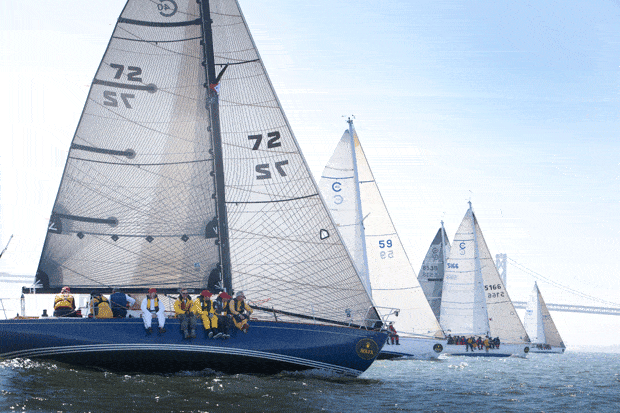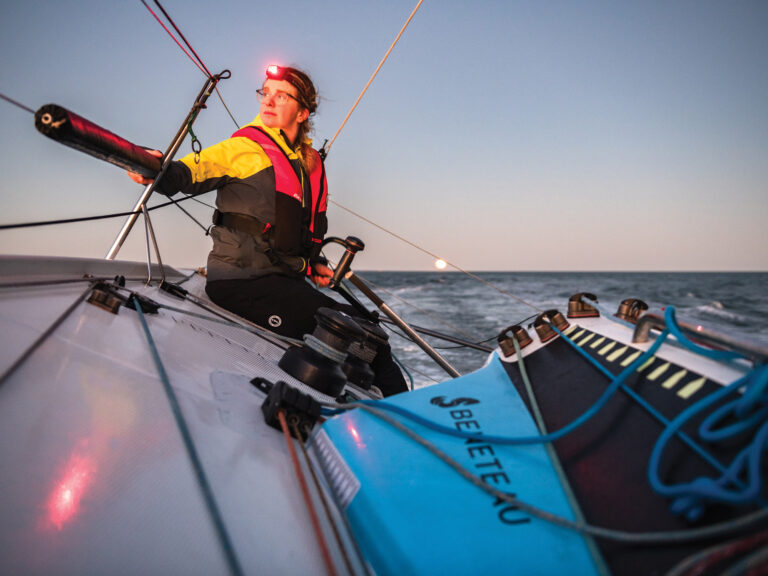
Cal 40
Many factors go into buying a sailboat, including price, availability, style, and how much the boat will be used off the racecourse. At the risk of adding another facet to an already complicated decision, we tasked PHRF guru Bruce Bingman with identifying a few boats that are likely to sail above their rating in certain conditions. As is the case with any single-number rating system, every boat will have a sweet spot, a combination of wind strength, sea state, and course configuration under which it will be tough to beat.
For this exercise we asked Bingman to focus on boats that would be predominantly raced in club-level weeknight or weekend races. We wanted boats that are lively, fun to sail, and available. In addition, we restricted him to boats with an average PHRF rating of 30 or greater. Below that number you tend to find dry-sailed race boats requiring professionally managed programs, which are beyond the scope of this exercise, and usually too fast to really race in most local series.
It goes without saying that for any even halfway serious racing, preparation is as important as the boat selected or the handicap rating with which it comes. We’ve all heard it 1,000 times before: There is no substitute for good sails, reliable gear, and a smooth bottom. You may think your two- or three-year-old sails look fine, but you will pick up 6 seconds per mile and more with a new inventory. The most carefully selected boat or the most favorable rating won’t help you overcome a mid-race breakdown such as a broken halyard or jammed winch. A dirty bottom can cost you 30-plus seconds per mile. Even a thin layer of slime will cost you 3 seconds per mile. So pick your weapon, gear up, burnish your bottom, and head for the start.
- Typical conditions: Waves and chop, strong but fading sea breeze
- **Typical racecourses: Multiple lap windward-leewards **
My summer weeknight beercan series is conducted outside the harbor, on an exposed ocean racecourse, so it’s usually choppy. Winds are typically strong sea breezes (15-plus knots) at the start of the race, but lighten as the race progresses. The race committee typically runs one long, three-leg, windward-leeward race.
Here’s where you want the dependable offshore workhorse, and there are many options. A moderate displacement boat, a powerful rig, and a sea-kindly hull will produce a boat that drives upwind, through chop, and carries a spinnaker large enough to preserve a lead.
PHRF 30 to 70: The Beneteau 40.7 is a great offshore racer that provides superior upwind ability in choppy, breezy conditions. Great for a distance races, too.
PHRF 71 to 114: The Beneteau 42s has power and waterline rolled together in a single package. The sails are big, so it requires recruiting some young bucks to help get around the course.
PHRF 115 and up: The Cal 40 is a classic design with the ability to go up and down the course in any condition.
- ** Typical conditions: Flat water, shifty winds can be strong or light**
- Typical racecourses: Mix of random leg and windward-leeward
My local weeknight beercan series is conducted on a sheltered, narrow lake, with very shifty winds, but no current. Winds tend to be at either end of the spectrum: It’s either drifter light or wipeout windy. Because of the prevailing direction and narrowness of the lake, there’s usually a lot of maneuvers on the random-leg courses.
In this scenario we’re looking for light boats that are on the smaller end of the size range for each of the rating bands, but still retain the ability to perform in breezier conditions.
PHRF 30 to 70: Although the Henderson 30 can be a handful in bigger breeze, it’s an excellent light-air performer and reaches like a bandit.
PHRF 71 to 114: The Antrim 27 is a very fast and fun light-air performer that’s great in a breeze, so long as there’s not a lot of chop.
PHRF 115 and up: The B-25, Leif Bailey’s original sporty speedster, is almost unbeatable under these conditions. An excellent, all-around performer that’s easy to drive around the course, and can still be found at reasonable prices.
- ** Typical conditions: Flat water, moderate winds**
- Typical racecourses: Random legs, all points of sail
My weeknight series is conducted in protected bay waters, with an average current of .5 to 1 knot, and generally flat water (with some chop at the upper wind range). Winds in the summer average 10 to 15 knots, and the organizing committee will typically run courses using government marks, requiring a mix of sailing angles.
In this scenario we want a boat with good all-around performance, especially for headsail reaches, a point of sail where many modern boats with non-overlapping headsails struggle. The 10- to 15-knot wind range is plenty to power most boats, so a very light boat, carrying a penalty for high sail-area-to-displacement ratio, will be at a disadvantage. This is particularly true in a “waterline” race, where a higher hull speed trumps maneuverability. On the other hand, a moderately light displacement boat with not too much wetted surface will ensure you’re not left out in the cold should the wind go light.
PHRF 30 to 70: The J/120 has consistently demonstrated excellent all-around performance to its typical rating.
PHRF 71 to 114: Either the Frers 41 or the J/29 masthead outboard. Both of these boats have overlapping headsails and enough power to get around the course and through the reaches. Which one is best would be dictated by local class splits. It’s generally desirable to be toward the faster end of the class.
PHRF 115 and up: The S2 9.1 was a MORC slayer in its heyday. It’s a very
fast, but comfortable, 30-footer with a powerful overlapping headsail and long waterline.
- Typical conditions: Steep chop, moderate winds
- ** Typical racecourses: Windward-leeward**
The races in my weeknight series are held on open, exposed, and typically choppy water, especially in moderate winds. The summer average is 10 knots, and the race committee usually runs windward-leeward courses.
Windward-leeward races are typically won upwind and lost downwind. In this scenario we’re looking for boats that will have good light-air performance to weather while retaining the advantage downwind. We also want to look for boats with relatively fine bow sections to get through the chop.
PHRF 30 to 70: The Farr 30 is still one of the best small windward-leeward boats ever designed (owner bias aside). It’s light and easily driven, but has a fine bow that can cut through the chop when needed. Thanks to the masthead spinnaker, it excels downwind in all breezes.
PHRF 71 to 114: The J/35 has excellent all-around traits. This workhorse provides great performance in the medium breeze, and the overlapping headsail really helps drive through the chop.
PHRF 115 and up: The C&C 35 MK I is often overlooked. With its low wetted surface, overlapping headsail, and narrow beam, it’s an excellent performer, particularly in the chop. The Mark III model, which has a deeper keel and more modern rudder design, is a strong windward performer, but pays in the rating game and is typically a good deal more costly.









